Introduction
While Indiana Gov. Mitch Daniels coyly dodges questions about his presidential intentions, he quietly raised more money for his state political action committee than any other potential 2012 Republican candidate.
According to a new report from the National Institute on Money in State Politics, Daniels’ Aiming Higher state-level PAC raised $2,182,953 in 2010. The next closest total during this time period comes from Mitt Romney’s Free and Strong America PAC, with $1,623,044.
Only two other candidates have raised money via state-level PACs, according to the report: Former Minnesota Gov. Tim Pawlenty’s Freedom First PAC, with $337,570 and former Pennsylvania Sen. Rick Santorum’s PAC, with a reported $2,250, plus an undetermined amount in Pennsylvania. The four combined to take in over $4.1 million during 2010.
In 2010, Daniels collected money through only one PAC, in his home state of Indiana. Romney, who collected almost $600,000 less than Daniels, registered PACs in Alabama, Michigan and the key primary states of Iowa, New Hampshire and South Carolina. iWatch News recently reported on Mitch Daniels’ tenure at pharmaceutical giant Eli Lilly. His state PAC received at least $80,000 from top Lilly executives in the 2004 and 2008 election cycles.
Under federal election laws, donors can give a maximum of $5,000 a year to a federal PAC. Those rules don’t apply to state-level PACs, and some states allow donors to give massive amounts of money to a candidate of their choice. The development of state level PACs is often seen as a sign of a serious presidential contender. Donors to state level PACs can contribute from all over the country, leading some campaign finance experts to worry that state level PACs create a back door to avoid federal campaign limits.
For example, Edward Conard of Bain Capital LLC maxed out at $5,000 to Romney’s federal PAC, but gave Romney another $68,000 through state-based committees. Romney helped found Bain.
“There’s a number of reasons people may create a PAC at either the federal or state level,” says Dave Levinthal of the Center for Responsive Politics. “At the end they benefit the candidate and allow for potentially the same people who are making and maxing out contributions at the federal level to have another entry point into supporting the general political efforts of somebody who may very well be running for president in the near future.”
Among Daniels’ largest contributors were Hoosiers for Economic Growth at $58,353 and Pennsylvania investor Jeffrey Yass at $50,000.
Brian McGrath, executive director of Daniels’ Aiming Higher PAC, told iWatch News that the PAC was “laser-focused on winning a majority in the Indiana House” during the 2010 cycle. “That was the only goal of our PAC activities.” McGrath said there were no plans to extend the PAC outside of Indiana state activity.
“No decisions have been made on what role Aiming Higher PAC might have going forward,” he said.
While state level donations create another avenue for candidates to solicit contributions, the amount raised thus far is tiny compared to what candidates will raise over the next two years. Romney’s $1,623,044 looks good until you consider that it took him all of 2010 to raise that amount. His phone bank drive on Monday brought in over $10 million in a single day.
The author of the report, Anne Bauer, told iWatch News that, given how campaign finance laws vary from state to state, it is possible that money was missed at the state level. She points to one particularly egregious example in Pennsylvania, where the secretary of state’s office could not locate Santorum’s disclosure filings.
The report, which covers only the year 2010, will be updated in the future with more recent contributions. Daniels own campaign disclosures show that Aiming Higher PAC has raised just over $60,000 in the first quarter of this year.
The report also noted potential presidential candidates who doled out money to state-level candidates. These funds could have come from either state or federal PACs. Doling out cash to support a local campaign can pay dividends when a local endorsement is needed.
The report found that eight Republican presidential wannabees combined to give just over $2 million to local candidates, over the course of the entire 2010 cycle. Again, Daniels’ Aiming Higher PAC took the lead, donating over $1.4 million to local candidates in his home state of Indiana. And again, Romney raised less money but was active in more locations, doling out $392,876 to candidates in 25 different states. Pawlenty contributed $167,251 to candidates in 14 states.
Other possible GOP candidates, including Santorum, Michele Bachmann, Sarah Palin, Ron Paul and Newt Gingrich, gave much smaller amounts in fewer states.
Reporter Laurel Adams contributed to this report.


Join the conversation
Show Comments